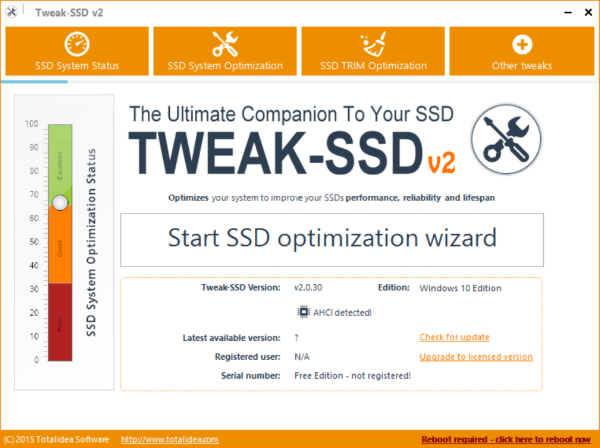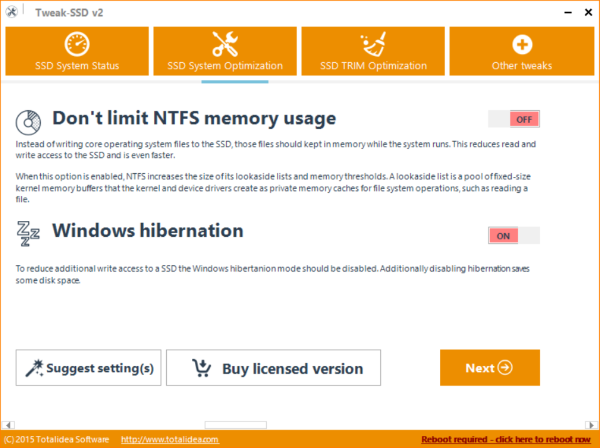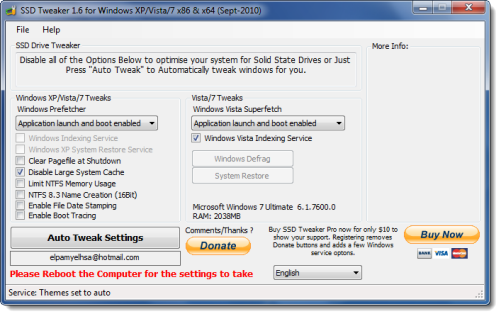Did your computer come with one of those fancy SSDs? Although SSDs are meant to be fast and provide fast reading and writing speeds, there might be a few times when you might not get the same speed and performance. Each SSD has some life and it can only take a fixed number of reading and write cycles. Although many tools let you evaluate the health and speed of your SSD. In this post, we’ve covered 2 free SSD optimization tools called Tweak-SSD and SSD Tweaker that let you optimize your SSD further so that you get the best out of it.
Tweak and Optimize Solid State Drives on Windows PC
SSD Tweaker & Tweak-SSD are free SSD optimization tools for Windows 11/10 that let you tweak, optimize and speed up your Solid State Drive by configuring best settings and reducing read and write access to your SSD.
1] Tweak-SSD for Windows
Tweak-SSD is offered in both free and premium variants and this post covers the free variant. The tool comes with a wizard-like interface and it is super simple to use. The initial or the first screen shows you some essential details about the SSD installed on your system. It will show you the existing optimization status and your current system’s specifications. You can click the Start SSD optimization wizard button to start with the optimization process.

Windows Prefetcher and Indexing Service
Disabling prefetch on SSD drives is recommended as it is not required. Also, SSDs are fast enough and file indexing is not required. Disabling file indexing can save you a lot of write cycles. But if you use Cortana, you should not disable file indexing on SSDs or Cortana won’t be able to find files. To enable recommended system settings, click on Suggest setting(s) button and Tweak-SSD will handle everything for you.
Memory Optimization
You can make Windows store system files in memory, saving a lot of reading and write cycles and making your computer perform a little faster. But this feature is only recommended if you have more than enough RAM on your computer. You can also force Windows to use the free RAM for disk caching so that you can save read and write access to the SSD.
Hibernation Settings
Hibernation must be disabled on Windows to reduce write access. When a computer goes into hibernation, it still accesses your SSD. So, disabling hibernation can reduce this access and also save some disk space.

File date stamping and Boot time defragmentation
You must have noticed the Date Modified attribute with every file on Windows. To maintain that property, Windows must write some data to the disk whenever you access or modify the file. This can be reduced by disabling file date sampling on your computer. Also, disabling boot time defragmentation for SSDs is recommended as SSDs are not required to be defragmented.
Page File
If your computer has a large amount of RAM, you do not need a page file, which Windows uses when RAM is almost full. Also, the page file is cleared on every shutdown, which means a few extra write accesses to the SSD.
These were some of the optimizations offered by Tweak-SSD. Apart from these features, there are a few more, such as Trim Performance Optimization, which is part of the paid version. The program is quite simple to use. The wizard-like interface will guide you through steps, and on every page, there is an option to configure the recommended best settings.
Click here on totalidea.com to download Tweak-SSD for your Windows PC.
2] SSD Tweaker for Windows PC

SSD Tweak Utility lets you adjust the following Windows settings in seconds:
- Windows Indexing Service
- System Restore
- Windows Defrag
- Use Large System Cache
- Ntfs Memory Usage
- Disable 8.3 Filenames
- Disable Date Stamping
- Disable Boot Tracing
- Windows Prefetcher
- Windows Superfetch
- Windows Services
You can download it from its Home Page.
Read:
- SSD Optimization Tips for better performance.
- Fix Slow SSD Read or Write Speed on Windows.